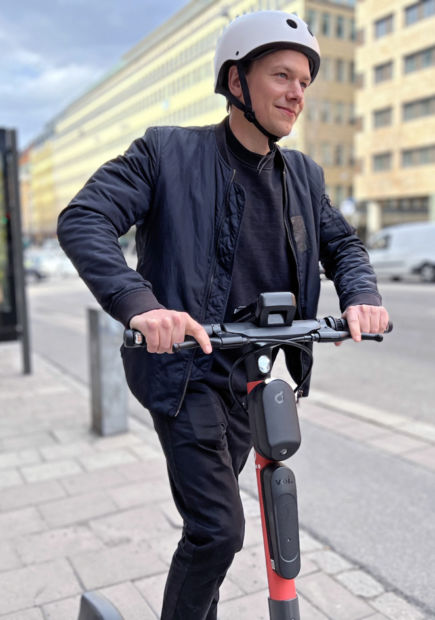Drover AI checks if Voi e-scooter riders are on the pavement
- May 9, 2022
- Steve Rogerson

Computer vision technology from Californian firm Drover AI is monitoring Voi e-scooters in the Norwegian capital Oslo.
Drover AI uses machine-learning and computer vision to identify accurately and reliably whether the e-scooter is on the pavement or sidewalk, road or cycle lane.
This is the first full-scale deployment of computer vision on e-scooters in Europe and will initially see hundreds of Voi vehicles installed with Drover’s PathPilot AI technology in Oslo, followed by other European cities later this year.
PathPilot should supercharge Voi’s geo-fencing capabilities as well as help the operator and local authority govern and control how and where scooters are ridden and parked.
Voi has been a pioneer when it comes to using technologies within the industry, be it geofencing accuracy or enhanced safety features, and is now tackling pavement riding and parking.
Voi was the first company to trial the use of computer vision on e-scooters last year in Northampton, UK. This full-scale launch will see hundreds of Voi vehicles fitted with Drover’s PathPilot AI technology in Oslo. Drover AI’s technology uses machine learning and computer vision to identify whether the e-scooter is on the pavement, road or cycle lane, to help prevent pavement riding.
PathPilot’s geo-fencing capabilities can produce precise results at a level that existing GPS-based technology cannot, particularly in a dense built-up environment such as Oslo. The technology, similar to the sensors used in autonomous vehicles, can also be linked directly to a scooter’s motor to slow the speed of the vehicle automatically when it enters forbidden rider zones, such as pavements. As well, PathPilot has the capability to train its parking algorithm to spot if a scooter is parked correctly. Using the camera as a sensor, the technology can help Voi and Oslo City Council govern and control how and where scooters are parked.
Through a successful rollout in the USA, Drover AI has proven that, out of the box, PathPilot is adaptable and easily scaled to new environments without the need for excessive training or expensive labour-intensive pre-mapping. Additionally, the European health and safety approved product does not require availability of any GPS data to function, allowing for location awareness and the ability to take corresponding actions.
Demand for shared micromobility is sky high in Oslo, with 70% of the city’s population downloading Voi’s app during summer 2021. Most Oslo riders experience a safe, comfortable and efficient ride, but Voi says it is committed to using innovation to ensure that every e-scooter ride in the city is a safe one.
By collaborating with Drover, Voi can build a record of where and how the scooters are being ridden in Oslo, helping inform algorithms that can prevent pavement riding and enable better scooter parking. PathPilot will also automatically deliver actionable insights on fleet use and rider behaviour, which Voi can then share with Oslo City Council to help improve the service. This could see the location of e-scooters optimised to reduce the risk of pavement riding while PathPilot can also recognise fallen scooters and flag them for corrective action.
By working in partnership with local councils and companies such as Drover, Voi says it is empowering people to leave their cars behind and move around their city in a safer, more sustainable way.
News of the partnership follows the recent launch of the Voiager 5, Voi’s safest and most durable scooter yet. Following the rapid rollout of the Voiager 4, Voi has built upon the design achievements of last year’s model and made them more sustainable for the V5. Among the additions is a revised dashboard, an integrated phone holder and a more ergonomic handlebar design aimed at those with smaller hands.
Deep analysis of repair cycles and quality assurance checks informed the improved design, so that the V5 sets an industry benchmark for durability. With components that are easier to repair and reuse, the V5 also has double the proportion of recycled materials compared with previous models, underlining Voi’s commitment to sustainability.
“Voi’s vision for 2030 is for micromobility to become a staple of urban living across the globe,” said Fredrik Hjelm, CEO of Voi. “But we know that vision can only become a reality if the micromobility industry prioritises the safety of users, pedestrians and other road users equally. That’s why we’re working with Drover to tackle the issue of pavement riding once and for all. By incorporating AI into our micromobility offering we believe we can nudge riders towards better parking and riding practices.”
Alex Nesic, chief business officer at Drover AI, added: “We’re delighted to be working with Voi on the first full-scale deployment of computer vision technology in Europe. It’s clear that micromobility has a key role to play in a sustainable future for urban transport and we know AI can help solve some of the industry’s toughest problems. We look forward to seeing what today’s news in Oslo will mean for the future of micromobility.”
Founded in 2018, Voi is a Swedish micromobility company offering electric scooter and e-bike sharing in partnership with cities and local communities. It operates in more than eighty cities across eleven countries. It is headquartered in Stockholm and employs 1000 people. To date, Voi boasts more than six million users and has served more than 100 million rides.
Drover specialises in AI-based IoT for last-kilometre transportation designed to elevate the performance of fleets while exceeding the regulatory requirements of the cities that host them. Drover’s PathPilot delivers granular infrastructure distinction even in the absence of GPS data allowing for location awareness and the ability to take corresponding actions.





